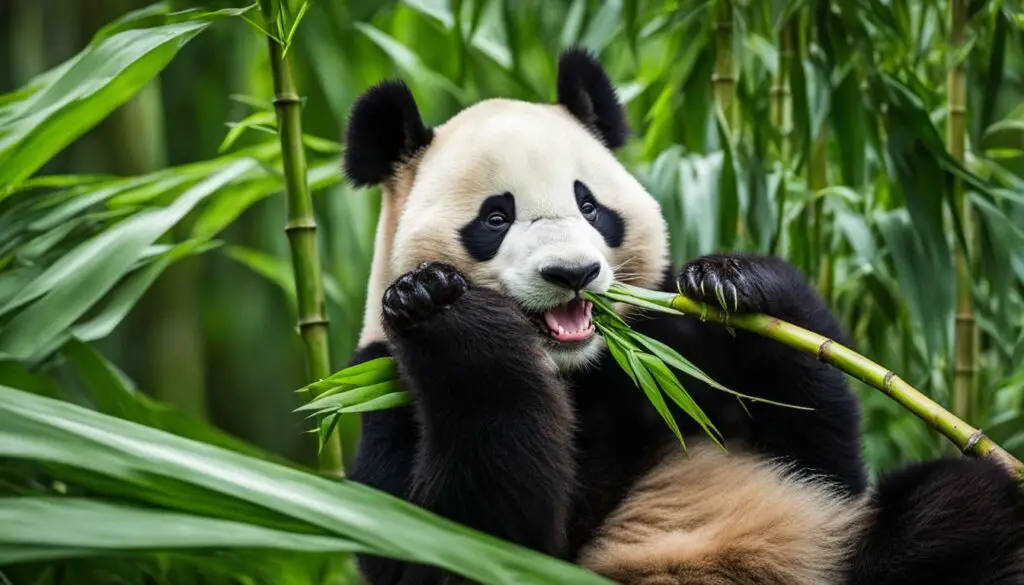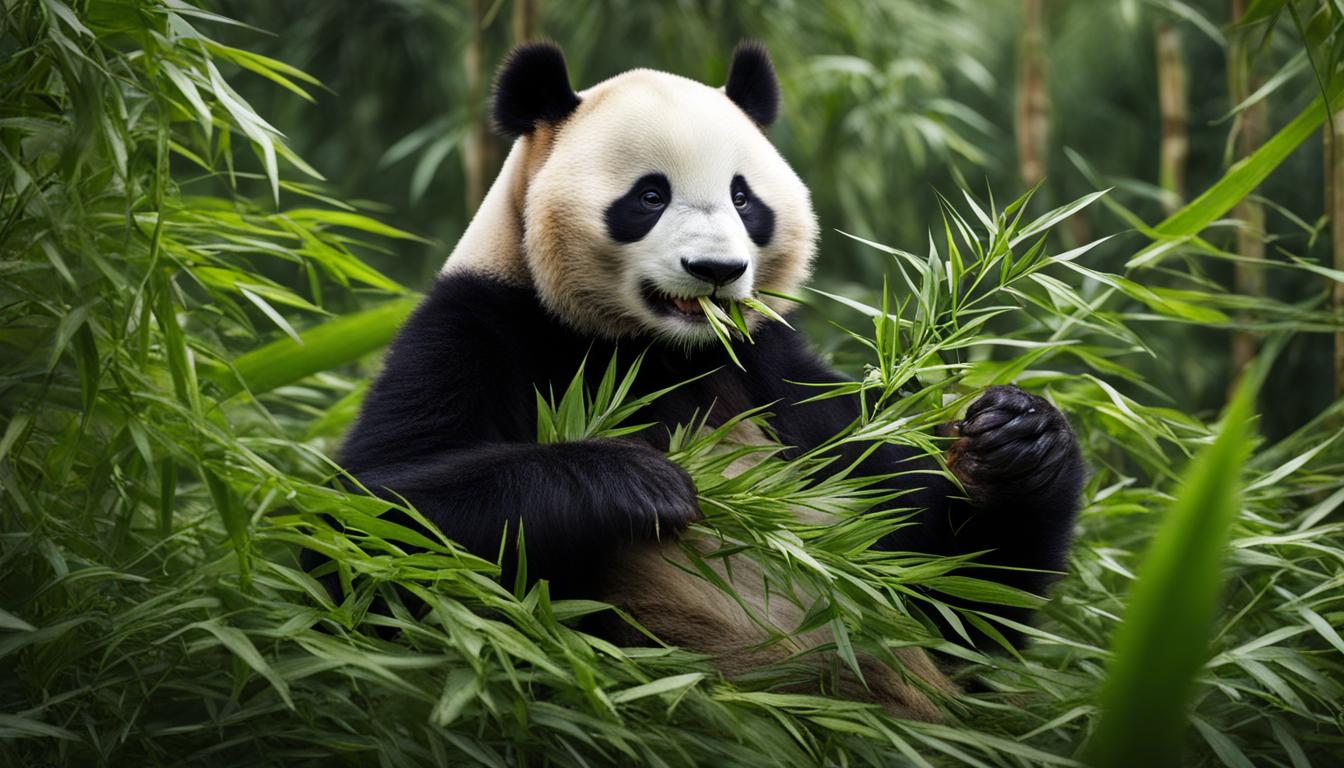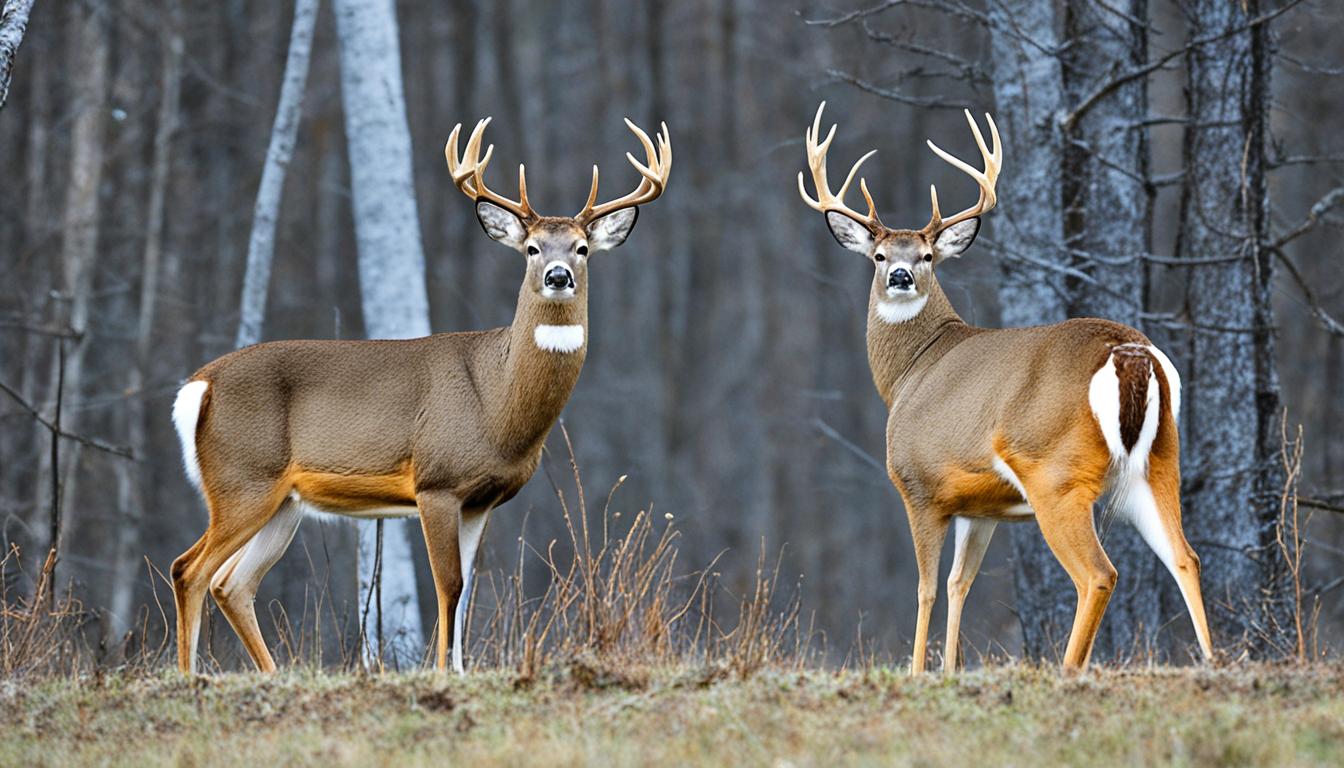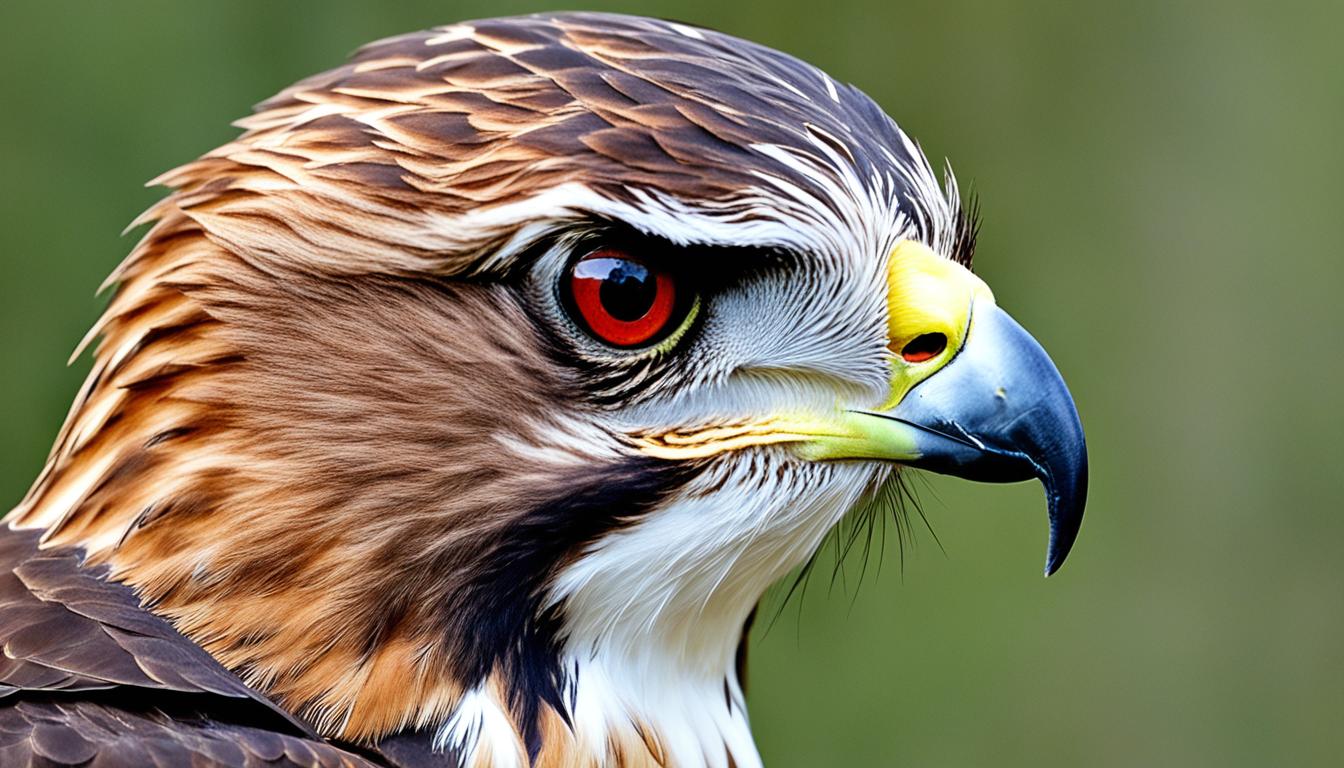Welcome to the fascinating world of giant pandas! These adorable creatures have captured the hearts of people worldwide. One of the most intriguing aspects of pandas is their diet and feeding habits. In this article, we will explore what pandas eat and how they acquire their food. So, let’s dive into the world of panda nutrition!
Giant pandas have a primarily herbivorous diet, with bamboo being their main source of sustenance. Although they possess the digestive system of a carnivore, pandas rely almost exclusively on bamboo, which provides limited energy and protein. To meet their nutritional needs, pandas spend up to 12 hours a day feeding.
Using their five fingers and specialized wristbone, pandas deftly grasp bamboo stalks, peeling off the tough outer layers to access the softer inner tissue. They also consume bamboo leaves, forming them into compact bundles and swallowing them. Their large size and round face are adaptations that have evolved to accommodate their bamboo-focused diet.
It’s intriguing to learn how giant pandas forage and search for food. They are known for their efficient foraging behavior, always striving to consume the maximum amount of food with minimal energy expenditure. This behavior helps them thrive in their habitats while conserving energy.
Throughout this article, we will delve deeper into the panda diet, including the importance of bamboo as their main food source, their feeding and drinking behavior, and even the occasional consumption of other food items. Understanding these aspects of giant pandas’ dietary preferences is vital for their conservation and well-being, both in the wild and in captivity.
Foraging Behavior
The giant panda’s foraging behavior is a fascinating aspect of its feeding habits. When searching for food in the wild, pandas display a preference for efficient foraging, using the least amount of energy to consume the greatest amount of food. Researchers have observed that pandas exhibit a specific pattern when presented with multiple feed containers arranged in a circle. They move from feeder to feeder in a circular motion, indicating their strategic approach to food search.
This behavior allows pandas to maximize their food intake while conserving energy, which is crucial considering their primarily herbivorous diet of bamboo, which provides limited energy and protein. By adopting an efficient foraging strategy, pandas can meet their nutritional needs in the most effective way possible.
“Efficient foraging behavior is essential for giant pandas to survive in their natural habitat, as it allows them to obtain sufficient food despite the low nutritional value of bamboo.”
Giant Panda Foraging Patterns
Giant pandas showcase unique foraging patterns that have evolved to adapt to their bamboo diet. Their foraging behavior highlights their ability to navigate their environment and secure a reliable food source. Understanding these foraging patterns not only provides insight into the dietary preferences of giant pandas but also contributes to their conservation efforts.
| Foraging Behavior | Description |
|---|---|
| Circular feeding | Giant pandas move in a circular pattern when presented with multiple feeders, indicating their preference for efficient foraging. |
| Food search | Pandas constantly search for plant material to consume, ensuring a reliable food source. |
| Energy conservation | Efficient foraging allows pandas to maximize their food intake while conserving energy. |
By studying the giant panda’s foraging behavior, researchers can gain valuable insights into their feeding habits, contributing to ongoing efforts to protect and preserve this iconic species.
Bamboo as the Main Diet
Giant pandas have a unique and specialized diet, with bamboo being their main source of nutrition. In fact, bamboo makes up over 99% of their diet, emphasizing its importance in their daily lives. These fascinating creatures consume an average of 12-15 kg (26-33 lbs) of bamboo per day, including the roots, shoots, and leaves.
The nutritional value of bamboo varies depending on the different parts of the plant. Shoots are highly favored by pandas due to their high nutritional value and low fiber content, followed by young leaves. Bamboo leaves contain the highest protein levels, while the stems have less. It’s interesting to note that pandas require at least two different species of bamboo to avoid starvation, as they rely on specific bamboo species available in their range.
The availability and quality of bamboo are crucial for panda populations, especially during late winter and early spring. Fluctuations in bamboo availability can impact their overall health and reproductive success. Therefore, understanding the relationship between pandas and bamboo is vital for the conservation and preservation of these magnificent creatures.
| Bamboo Part | Nutritional Value |
|---|---|
| Shoots | High protein, low fiber |
| Young Leaves | Good protein content |
| Stems | Less protein, more fiber |
Panda’s Varied Diet: Beyond Bamboo

Although bamboo is the primary food source for giant pandas, they are not limited to a strict bamboo diet. Pandas have been observed consuming other food items opportunistically, showcasing their adaptability and dietary flexibility.
“Pandas have a remarkable ability to eat various non-bamboo food items in the wild,” says Dr. Mei Zhang, a leading panda researcher.
“It is not uncommon to see pandas hunting small animals such as rodents and birds. They have even been spotted catching fish from streams.”
In addition to small animals and fish, pandas have also been observed consuming flowers. While flowers do not make up a significant portion of their diet, they provide a source of additional nutrients and variety.
| Dietary Component | Occurrence in Panda’s Diet |
|---|---|
| Small Animals | Opportunistically |
| Fish | Occasionally |
| Flowers | Infrequently |
In captivity, pandas may also receive supplementary food to ensure their nutritional needs are met. Carrots, yams, and specially formulated leaf eater biscuits are commonly provided to supplement their bamboo diet and provide necessary vitamins and minerals.
While bamboo remains the primary dietary component for giant pandas, their ability to consume non-bamboo food items showcases their adaptability and resourcefulness, emphasizing the importance of a varied diet for their overall health and well-being.
Panda Feeding Habits and Drinking Behavior
Giant pandas have unique feeding habits that revolve around their primarily bamboo-based diet. Spending around 14 hours per day feeding, pandas assume a sitting position and use their teeth to strip the tough outer layers of bamboo before consuming the inner tissue. This efficient eating process allows them to quickly pass food through their digestive system.
Despite their herbivorous diet, pandas do not consume much water directly from their food. Instead, they typically drink water at least once a day, often from standing pools. However, pandas have a water imbalance, eliminating more water in their feces than they ingest from their food. To compensate for this, pandas may consume wet bamboo during the rainy season.
Pandas’ feeding habits and drinking behavior are adaptations to their bamboo-centric diet and their natural habitat. These behaviors, along with their specialized wristbone and powerful jaw muscles, enable pandas to efficiently extract nutrition from bamboo and thrive in their environment.
Dietary Comparison with Other Bears
The giant panda’s diet is distinct from other bears due to its overwhelming reliance on bamboo. While most bears incorporate a significant amount of plant matter into their diet, the giant panda stands out for its almost exclusive consumption of bamboo. This unique dietary preference sets the panda apart from its bear counterparts.
Unlike other bears, who typically rely on plants for at least 75% of their diet, the giant panda’s diet consists of more than 99% bamboo. This singular focus on bamboo distinguishes the panda as a specialist in bamboo consumption.
It is important to note that not all bears follow a herbivorous diet. For instance, polar bears are primarily carnivorous, feeding on seals and other marine mammals. Their diet sets them apart as unique among the bear species.
In summary, while most bears consume a variety of plant matter, the giant panda’s diet is exceptional due to its exclusive reliance on bamboo. This dietary specialization is a defining characteristic of the giant panda and contributes to its distinct ecological niche.
Conclusion
The giant panda’s diet primarily consists of bamboo, which provides limited energy and protein. As a result, pandas spend a significant amount of time foraging and feeding to meet their nutritional needs. While bamboo makes up the majority of their diet, pandas can also consume other food items opportunistically.
Understanding the feeding habits and dietary preferences of giant pandas is crucial for their conservation and preservation in both the wild and captive settings. By studying their foraging behavior and preferences, researchers can develop effective strategies to ensure pandas have access to a diverse range of bamboo species and other suitable food sources. This knowledge helps in creating conservation plans that promote the long-term survival of these iconic and endangered animals.
Furthermore, in captive settings such as zoos and reserves, providing a varied diet that includes supplements like carrots, yams, and leaf eater biscuits ensures that pandas receive the necessary vitamins and minerals. This helps maintain their health and well-being, contributing to their overall preservation efforts.
Are Giant Pandas Able to Survive on a Diet that Doesn’t Consist Mainly of Bamboo?
Giant pandas’ dietary habits are highly specialized, with bamboo making up 99% of their diet. However, they are also known to consume small mammals, birds, and insects in the wild. While they can survive without bamboo, it is crucial for their health and reproduction.
FAQ
What do giant pandas typically eat?
Giant pandas have a primarily herbivorous diet consisting almost exclusively of bamboo. They consume an average of 12-15 kg (26-33 lbs) of bamboo roots, shoots, and leaves per day.
How do giant pandas feed?
Pandas use their five fingers and specialized wristbone to grasp bamboo stalks and peel off the tough outer layers to access the softer inner tissue. They also eat bamboo leaves, wadding them up and swallowing them.
What is the foraging behavior of giant pandas?
Giant pandas secure their food source through foraging, constantly searching for plant material to consume. They follow the basic foraging rule of using the least amount of energy to consume the greatest amount of food.
Why is bamboo the main diet of giant pandas?
Bamboo makes up over 99% of the giant panda’s diet. It provides limited energy and protein, so pandas must spend up to 12 hours a day eating to meet their nutritional needs. Their large size and round face are adaptations to their bamboo diet.
Do giant pandas eat anything besides bamboo?
While bamboo is their primary food source, giant pandas may also eat other food items opportunistically. In the wild, they have been observed consuming fish, small animals, and even flowers.
How do giant pandas feed and drink?
Giant pandas assume a sitting position and use their teeth to grasp and strip the tough outer layers of bamboo before eating the inner tissue. They spend about 14 hours per day feeding and typically drink water at least once a day.
How does the giant panda’s diet compare to other bears?
Unlike other bears, the giant panda’s diet is unique due to its almost exclusive reliance on bamboo. While most bears consume a significant amount of plant matter, the giant panda’s diet is overwhelmingly bamboo-based. However, pandas still retain some carnivorous characteristics.






